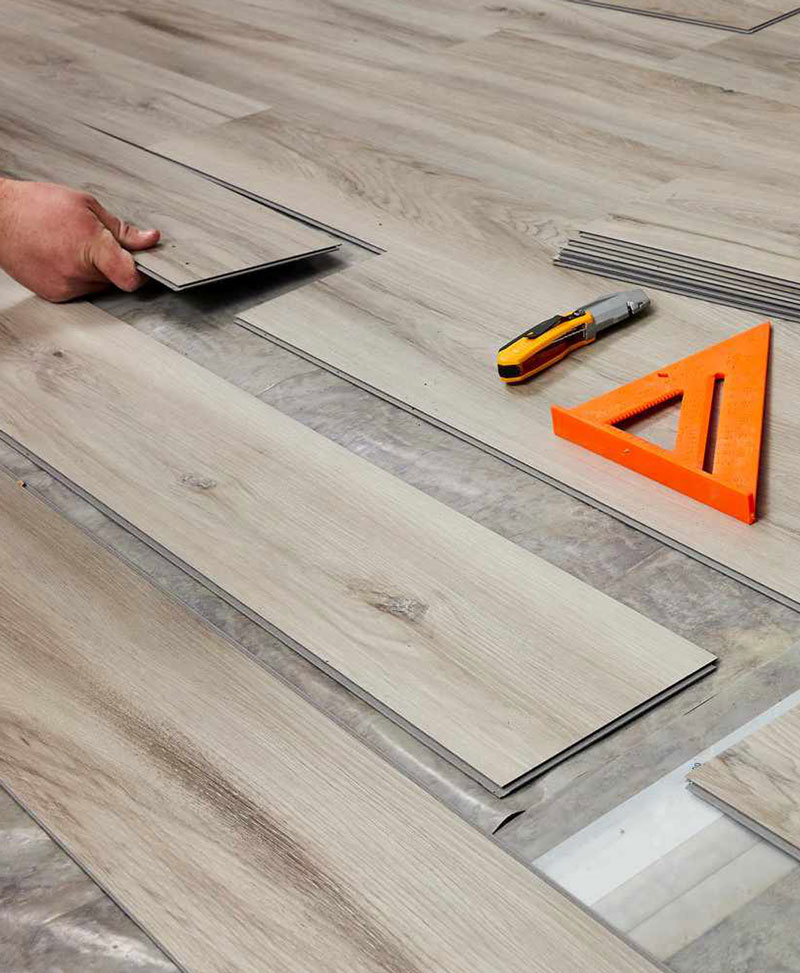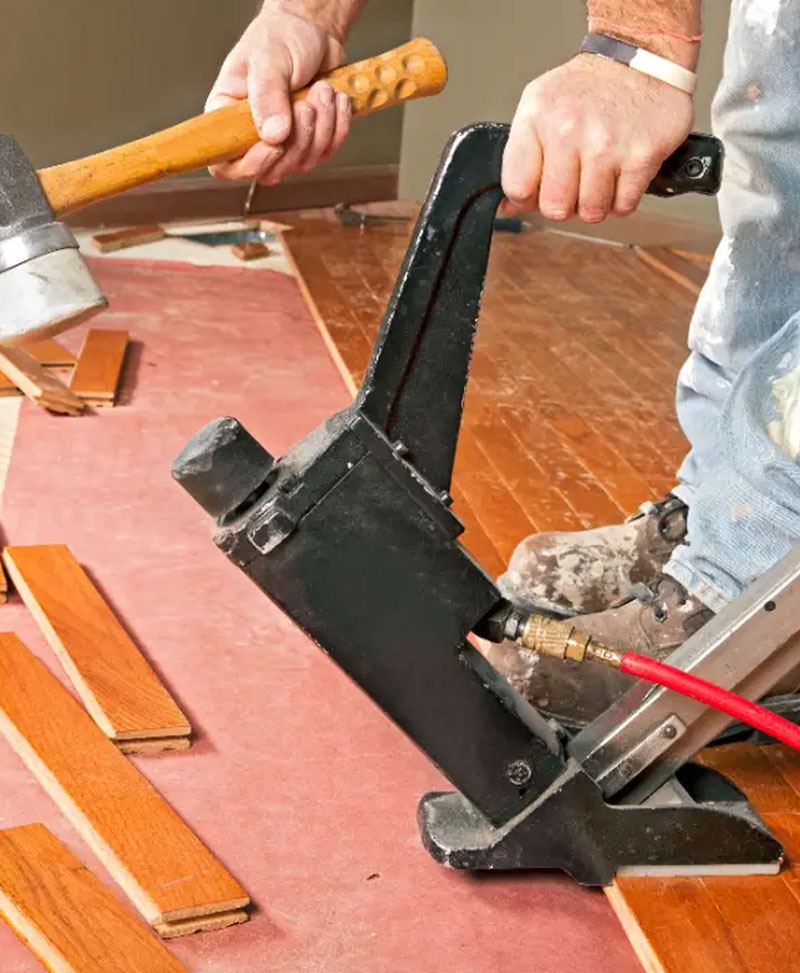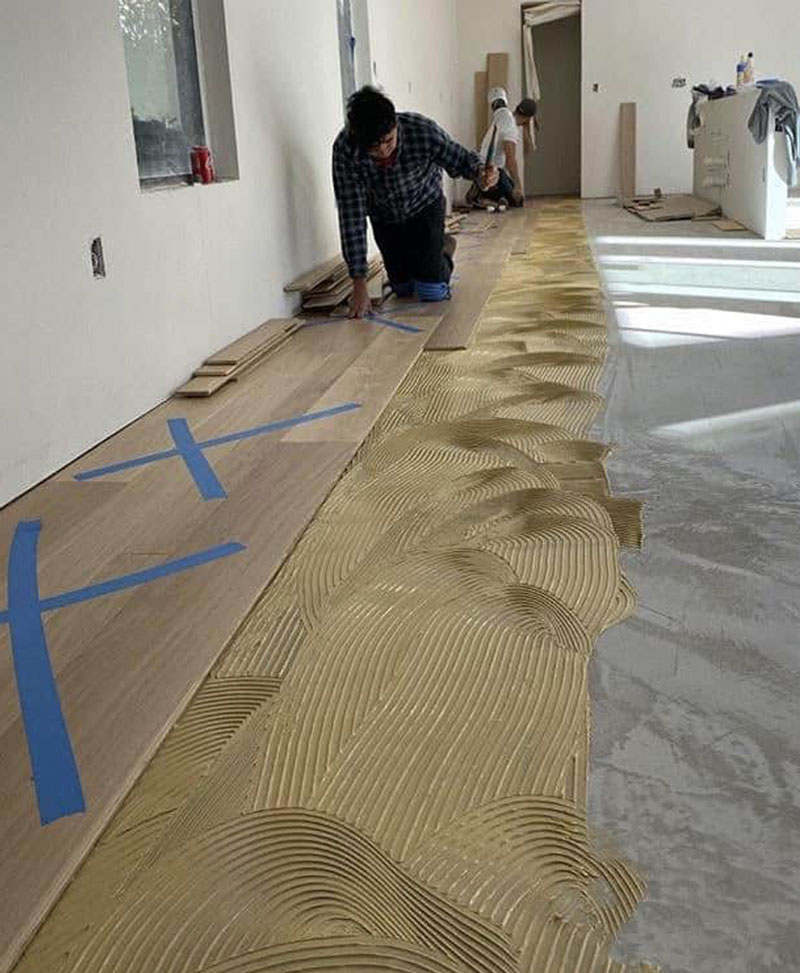Ways To Install
It isn’t enough to pick the hardwood or laminate flooring that’s best for you, your home, and your lifestyle. For maximum life with minimum problems, the floor you choose must be properly installed.
Whatever type of flooring you choose it must be installed according to the manufacturer’s guidelines. The area must be carefully prepared. And the installation must be done with intense attention to details.
There are three ways that hardwood and laminate floors are installed today. Follow the links below for more information on each way.
Floating floor installation is the most popular ways to install a floor. It can be used in a wide variety of situations, including basements and condominium apartments. It is only suitable for laminate and engineered flooring.
Nail Down installation will work for solid or engineered flooring with minimum 19 mm thickness. Your hardwood flooring will be nailed or stapled to a subfloor.
Glue down installation is primarily used on concrete slabs that are on grade. In condominiums the floor is glued on top of an acoustic underlayment such as cork. This minimizes noise for your neighbors.
Floating Floor Installation
Many people ask us what “floating floor installation” means. Sometimes they’re concerned about whether their floor will be properly anchored. Sometimes they just want to know what “floating” means.
The best way to explain is to contrast floating floor installation with Nail Down or Glue Down installation. With either of those if you walk to the center of the room, the board that you’re standing on will be directly attached to the subfloor underneath.
With a Floating Floor installation the floor is suspended above the subfloor. It rests on a cushioned underlayment. It is only suitable for laminate and engineered flooring. Oak is an excellent choice for this kind of installation.
Here are the steps that our professional Flooring Consultant and flooring installers will take for a Floating Floor Installation.
Planning comes first. We will make sure that a Floating Floor installation will work in your specific situation. Your Flooring Consultant will ask you some questions to help us evaluate it.
Preparation is crucial. We’ll make sure that what’s under your new floor will be exactly level, with all low spots filled in. We’ll install the right moisture barrier for your situation.
To make sure your warranty remains in force, we’ll install the floor according to the manufacturer’s guidelines. These are guidelines for both materials and installation methods.
There are some disadvantages that come with a floating floor installation. There is often a feeling of mild instability when you walk over it. With a floating floor installation it is absolutely essential to use proper techniques and materials to prevent problems later.
However, these disadvantages are easily countered by the benefits of using floating hardwood floor: ease of installation and maintenance, low cost, the ease with which it can be changed and the comfort it creates for walking, since it uses cushioning between the panels and the sub floor.

Nailed Down Installation

With Nail Down installation your floor is nailed or stapled directly to a subfloor. It’s often the choice for solid wood flooring which is often thicker than other types. Here are the steps that our professional Flooring Consultant and flooring installers will take for a Nail Down Floor installation.
It all starts with planning. This includes making sure that you have a proper subfloor and that the floor can be installed according to manufacturer’s guidelines.
The installers start their work by preparing the floor. They’ll assure that the subfloor is properly anchored and swept clean. They’ll make sure that the flooring runs in the proper direction. And they’ll install the floor using tools and procedures specified by the flooring manufacturer.
A nail down installation can offer you some usage advantages over other installation methods. The glued down floors are rigid, once a floor panel is dried to the subfloor, it’s there for good whether it’s snug to the next panel or not. A floating floor isn’t attached to anything and therefore can be creaky, bouncy and even move around.
A nailed down floor is easier to install and remove, leaving almost no trace behind if you need to replace it. That’s an advantage over a glue down installation, which requires a lot of clean-up after floor removal.
Glued Down Installation
With Glued Down installation, your floor is attached to the subfloor with an adhesive. This method is most commonly used over a concrete slab that is on grade. Here are the steps that our professional Flooring Consultant and flooring installers will take for a Glue Down floor installation.
We’ll make sure that Glued Down installation is the best choice for your situation. We’ll make sure you’re using a type of hardwood that’s suitable for gluing.
One of the most important steps is preparing the subfloor. It will be used as a means to fix your hardwood floor in place. That’s why it’s imperative that the subfloors surface is clean, dry and as smooth as possible.
We’ll assess the location, condition and use of your floor to make sure that Glued Down installation will work. Our installers will install your flooring using materials and methods specified in the manufacturer’s guidelines. We’ll take care to use adhesives that are non-toxic and environmentally friendly.
Gluing down hardwood or laminate floor is great for comfort, stability and durability. It usually prevents the annoying squeaking that many other types of installation methods produce. The only downside is that it’s very hard and messy to replace.

The floors in your home or office can look better
We don’t need to convince you – our work speaks for itself. Call us today for a free consultation and quote!
